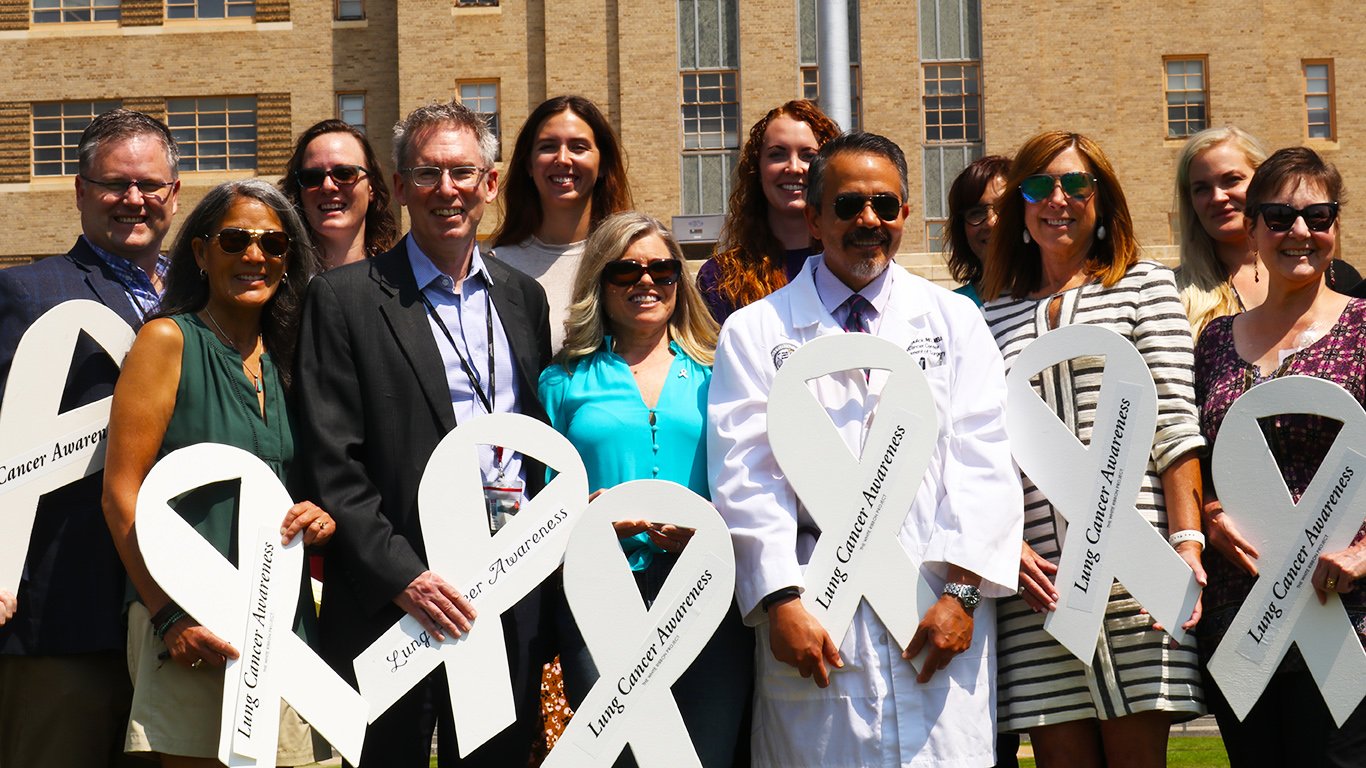Comedian Kathy Griffin’s recently announced lung cancer diagnosis came early and arose from a non-related health screening. A lucky catch, and an understandable path to detection for a person who never smoked.
Yet chance findings account for many lung cancer diagnoses today, and a majority (about 84%) of all diagnoses are delivered at grimmer later phases than Griffin’s more treatable stage 1. Former and current tobacco users, whose deadly habit remains the chief cause of the top cancer killer of both sexes, account for the brunt of those cases, at about 90%.
It doesn’t have to be that way, say cancer prevention experts on the University of Colorado Anschutz Medical Campus. Besides stopping smoking, studies show that today’s advanced lung cancer screening saves lives, according to Jamie Studts, PhD, co-leader of the University of Colorado Cancer Center Prevention & Control Program.
But for “every reason you can imagine,” the potentially “game-changing” technology goes underused – and stigma remains a chief deterrent, Studts said.
Lung cancer’s changing landscape
Lung cancer deaths continue a downward trend in this country largely because of smoking cessation and treatment advances, said Studts, a professor of medical oncology at the University of Colorado School of Medicine (SOM).
Between 2014 and 2018, lung cancer mortality rates fell 5.2% in men and 4.3% in women, the starkest decrease in cancer deaths during that period second only to melanoma, according to the Annual Report to the Nation 2021: National Cancer Statistics.
“We’re still riding that decline in tobacco use that was started in the 1960s,” Studts said, referencing the first Surgeon General’s report in 1964 linking smoking to lung cancer and heart disease. “We’re finally realizing some of those dramatic changes.”

Jamie Studts, PhD, left, poses with CU Cancer Center team members during a lung cancer awareness event on campus. |
Advanced treatments also play a role in the decline. “We’re actually treating lung cancer more effectively,” Studts said, pointing to targeted therapies, including immunotherapies, offered at the CU Cancer Center. “They are just dramatically changing the landscape of lung cancer.”
Stigma plays big role in healthcare gap
Yet smoking remains the leading cause of preventable disease, disability and death in the United States, according to the Centers for Disease Control and Prevention. Each year, one of every five deaths in this country results from tobacco use.
“The next biggest game-changer that we haven’t fully realized yet … is the development of early detection or lung cancer screening using low-dose computed tomography (LDCT) for individuals with high risk,” Studts said.
Studts, who has studied for years the reasons behind the phenomenon of underused LDCT screening, and his colleague Nina Thomas, MD, SOM assistant professor in the Division of Pulmonary Sciences and Critical Care and director of the Lung Cancer Screening program, said shame remains a top barrier.
“There’s this huge stigma around lung cancer,” said Thomas, who studies smoking behaviors and lung cancer. “People unfortunately place blame on the patient for developing lung cancer, because most lung cancers are associated with a history of smoking.”
Reversing the stigma and lack of screening requires that healthcare providers take the lead, Studts said. “People with a history of smoking have not been treated very kindly in our healthcare system. So, there’s stigma and biases as well as self-blame that plays a prominent role.”
Prevention experts are promoting a cultural shift of viewing smoking as a disease, Thomas said. “It’s an addiction, and we shouldn’t be stigmatizing their previous behaviors. That does not bring them into the clinic so that they can be screened and taken care of.”
One of Studts’ first studies on lung cancer and screening found that half of patients who underwent the scanning did not tell family members.
“It’s an addiction, and we shouldn’t be stigmatizing their previous behaviors. That does not bring them into the clinic so that they can be screened and taken care of.” – Nina Thomas, MD
“Fifty percent,” Studts said. “Could you imagine if a woman were scheduled for a mammogram and felt so ashamed that she had to go get one that she wouldn’t tell anybody: her daughters, her mom, her husband, her partner, even her doctor, in some situations?”
Poor rollout, insurance affect screening
Studies show LDCT screening reduces lung cancer mortality by 20%. Partially in response to those studies, which found LDCT more effective than X-ray screening, the U.S. Preventive Services Task Force in March expanded the recommended target group for the annual screening.
In hopes of detecting more early-stage disease in high-risk populations, the age for LDCT screening was lowered from 55 to 50 and the pack-year history dropped from 30 to 20 years. People who currently smoke have quit within the past 15 years are considered the at-risk target group.
“Hopefully, those changes, if we can implement them properly, will help mitigate some of the high mortality rates for lung cancer,” Thomas said, touching on another major hurdle: implementation.
“Institutions have not responded in the same way in terms of rolling out enough programs and really supporting them effectively and understanding them,” Studts said. “Primary care clinics have been tasked with being the engine to get this process going, but there is still misinformation and lack of awareness among primary care clinicians.”
“Could you imagine if a woman were scheduled for a mammogram and felt so ashamed that she had to go get one that she wouldn’t tell anybody: her daughters, her mom, her husband, her partner, even her doctor, in some situations?” – Jamie Studts, PhD
Insurance red tape also creates issues, Thomas said. “One of the challenges is waiting for the insurance to catch up to guidelines,” she said, adding that she hopes for nationwide Medicaid and Medicare expansion to help cover lung cancer screening for all those who will now be eligible.
Better access, provider education needed
Disparities in healthcare access create more barriers, disproportionately affecting populations from rural residents and members of the LGBTQ community to ethnic minorities and people of lower economic and educational status, experts say.
“All of that is going to continue to be a problem that just changing the guidelines is not going to fix,” Thomas said. “We need to get them better access to our clinics so we can diagnose and treat them at an earlier stage, which is associated with better outcomes.”
“Luckily, here on our campus, we do have options for charity care and support once they have a diagnosis of lung cancer,” she said, noting CU Anschutz’s “amazing” social workers, who can even help with financial assistance, caretaker support, transportation and hotel accommodations for long-distance residents.
In addition to supporting patients through smoking cessation, healthcare providers need to educate at-risk patients about LDCT screening, Studts said.
“There’s a whole host … of strategies to help reduce those challenges in terms of helping people see it as a viable strategy to improve their health,” Studts said. “But we have a long way to go.”





